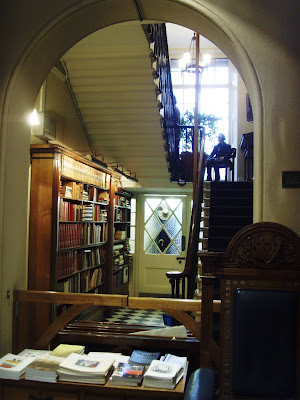As one of over forty artists invited to submit an outline proposal for a new Arts Council England site responsive project, 'Maggs beneath the Covers', I was faced with a challenge. Choosing one book from amongst the vast collections of Maggs Bros Antiquarian booksellers (www.maggs.com) seemed daunting at first. A bit like searching for the one perfectly round pebble on a shingle beach or an uncracked cup in a sea of shards - except that here everything was potentially perfect in its own way if only one could see it in the first place. How would the mind's eye adjust to, and begin to make sense of the sheer volume of volumes at Maggs? the overwhelming tsunami waves of personal, social, historical, cultural and political matter? How to begin the cognitive/creative process of sifting, categorising, selecting? Perhaps, I hoped, the one book would just eventually leap into view, standing out from all the others and calling out to me, "Stella, I choose you!"
Taking on the mantle of a cultural anthropologist I tried to listen and carefully observe, making notes and taking photographs as we were given a tour of the various departments, which included Early British, Travel, Continental and Illuminations, Autographs and Manuscripts and Counterculture. We all smiled as one of the directors cut through any fine-grained classification systems and subsumed all this stuff under the three broad-brush categories of 'white books, brown books and shiny books'. 'White books', which could also be manuscripts, are the earliest - often written on, or bound in, vellum and dating back centuries.
'Brown books' are so-called because they are often bound in leather - albeit not always brown in colour and 'shiny books' is the catch-all, dealers term refering to anything from more recent times which might nowadays even include computer hard-drives or e-books.
I have to admit that my magpie eye finds it hard to resist anything shiny - even the foil covered Easter bunny on the mantlepiece in the Autographs and Manuscripts department seemed to be winking at me in a mischevious way - 'why not choose me?'. Or perhaps it was because I'd skipped breakfast and was begining to feel a bit light headed from all the information overload that the promise of a quick sugar-rush seemed so appealing.
There was much food for thought: the whole of Captain Cook's journals from his voyages of discovery - a sensation in their time like a trip to Mars. Stacks and stacks of political pamphlets - the eighteenth century equivalent of blogging - a whole society ranting to itself. Two leaves from Marco Polo's journal found under a fly-leaf having been re-cycled as bookbinder's waste. A series of exquisitely illuminated capitals cut from their manuscripts and flogged to a Grand Tourist who then collaged them into a scrapbook like holy iconography from last year's Christmas cards.
Another job for the book doctor - re-uniting these Capitals with the
body of the text from which they were cut.
JEWEL TRAP 2010 Stella Harding. Photo: Sylvain Deleu
We were given only a few days to write and submit a proposal. Despite knowing hardly anything about the book, not even its title, the plight of its imprisoned owner desperate to find some space to communicate his thoughts stirred in me a desire to make something of its story. It seemd fitting to propose making a basketry form which would reference the darker side of containment - to trap and constrain, cage and kill. I had touched on this theme before in other site responsive projects at Pitzhanger Manor and the Petrie Museum (see previous posts). This time I wanted to use it to highlight the cause of the many hundreds, possibly thousands of writers, jounalists, poets and bloggers who today are imprisoned, tortured, sometimes killed for speaking out against repression.
I was thrilled and excited when I got a call from curator Penny Green to say that my proposal had been accepted and I could hardly wait to get started. First thing was to contact English-pen - the local branch of a worldwide organisation, Pen International, which campaigns for the freedom to write and to read. www.englishpen.org . Cat Lucas co-ordinates their Writers at Risk programme and could help identify and put me in touch with writers currently in prison.
Next thing was to email staff in the Continental and Illuminations department at Maggs to arrange another visit to find out as much as possible about the little book. I wanted to hold it, turn its pages, see for myself the hand-writing betwen the lines, learn more about its owner, make drawings and photograph it. Penny Green's vision as curator was that our finished works would be displayed as close as possible to where the chosen book was kept. Visitors to the exhibition would be free to explore the public areas of Maggs and discover both the artworks and the books that had inspired them.
When I got an email inviting me for a second visit it also contained some disappointing news. What each of the chosen artists had been warned could happen, had happened. Maggs Bros, who have been in business since 1853, had done what one of the world's leading antiquarian booksellers does best.
They had SOLD my book! ...........















